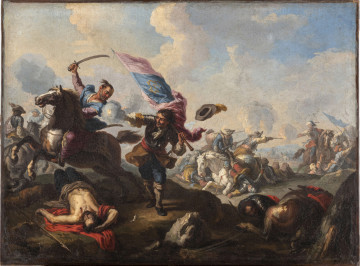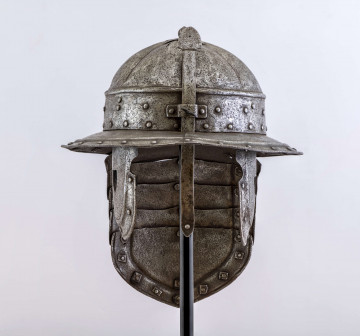
Skirmish with Turks
1700 — 1720
National Museum in Lublin
Part of the collection: Folk Art of the Lublin Region (17th–1st half of the 20th c.)
In Poland the woodcut became popular at the end of the 15th and the beginning of the 16th century. At that time around printing houses, established in the largest cities, began to gather craftsmen who were making pictures carved in boards. Sources mention illustrated prayers to Our Lady of Czestochowa, sold among the townsfolk, as well as other woodcut images distributed at fairs, markets and indulgences. This technique was also used in the production of paper wall coverings (kołtryn) or playing cards.
Folk wood engraving developed in the second half of the 18th and early 19th century. In villages and small towns mainly devotional pictures were distributed by Pauline Fathers, Dominicans, Carmelites, Franciscans and other congregations. The creators of woodcuts came from guilds, and workshops were organised in numerous pilgrimage sites. The likenesses of miraculous images were purchased by pilgrims, who believed that with them they were bringing divine protection to their families and households. Local pilgrimage places were also popular, among others: Leżajsk, Tursko near Pleszewo, Kobylanka, Kodeń in Podlasie, Radecznica.
Images of images from sanctuaries, with Christological and Marian themes or depictions of patron saints, were stuck inside the lid of dowry chests, above animal mangers, framed and hung on walls. They were to bring the sacred closer and ensure prosperity. Woodcuts also had an aesthetic function, especially those decorating the walls of quilts, which reproduced floral and geometric ornaments from book ornaments or old upholstery fabrics. Relatively rarely the prints depicted secular scenes and figures: robbers, hussars, bearers. More interesting is the depiction of two riders with sabres, galloping on horses. Also, puzzling is the lack of attention to detail and the failure to maintain proportions; in contrast to the animals, shown in motion, the figures in the half-rotation, with faces en face, are flat and stiff.
The woodcut, hand-coloured with yellow, black, brown and orange water colours, was found in a painting on glass depicting Christ Crucified, where it served as a support for the board that formed the back of the painting.
Author / creator
Dimensions
cały obiekt: height: 33,5 cm, width: 37,5 cm
Object type
colored woodcut
Technique
woodcut
Material
laid paper
Creation time / dating
Creation / finding place
Owner
The National Museum in Lublin
Identification number
Location / status

1700 — 1720
National Museum in Lublin

1501 — 1600
National Museum in Szczecin

17th century
National Museum in Lublin
DISCOVER this TOPIC
National Museum in Szczecin
DISCOVER this PATH
Educational path